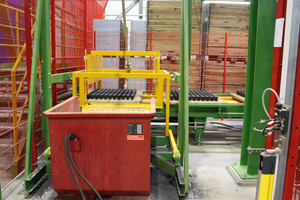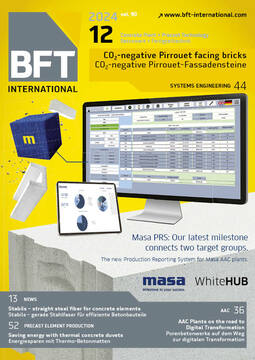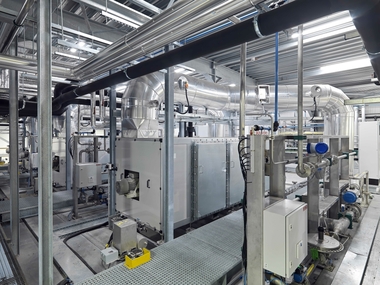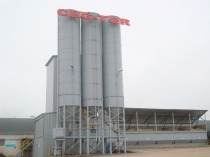Vandersanden Opens Pirrouet Production Facility in Lanklaar with New Brick Press from Rekers (Part 1)
With an investment of €32.5 million, the Vandersanden Group established a new plant in the Belgian city of Lanklaar dedicated to the production of Pirrouet facing bricks. The heart of this pilot facility is the innovative RSP-500 brick press from Rekers GmbH Maschinen- und Anlagenbau, located in Spelle. Read part 1 here, the second part will follow in BFT 01/2025.
With over 800 employees across 14 locations in Europe and the United Kingdom, Vandersanden ranks among the largest and leading family-owned brick manufacturing companies in Europe. Its product portfolio includes, among others, facing bricks, brick slips, paving bricks, and recently, the CO2-negative facing bricks Pirrouet. With an investment of €32.5 million and an EU research grant of €2.2 million, the Vandersanden Group established a new plant near the tri-border area close to Aachen with 26 employees on an 8,000 m² site dedicated to the production of Pirrouet facing bricks. The heart of this pilot facility is the innovative RSP-500 brick press from the medium-sized family business Rekers GmbH Maschinen- und Anlagenbau, located in Spelle. This cutting-edge brick press enables a current production capacity of 20 million facing bricks annually, which can potentially be doubled to 40 million with planned additions of a second press. This brick press opens new production possibilities for forward-looking products, while saving energy and resources compared to conventional machinery.
The plant was officially inaugurated in September 2024, marking another milestone in Vandersanden’s sustainability concept. But that‘s not all, Vandersanden has also been awarded the German Sustainability Award (DNP) in the area of climate change with its CO2-negative Pirrouet facing bricks.
Focus on Sustainability
The new production facility will exclusively produce climate-friendly products under the Pirrouet label. These sustainable facing bricks are set as the standard, meeting specific requirements, including 80% recycled material and 60 kg of CO2 binding per ton of facing brick.
In addition to the products, employee well-being is also a priority. The modern production facility provides excellent working conditions with ample natural light and high operational safety. The plant is designed to minimize employee exposure to noise and dust and features a maintenance-friendly layout for ergonomic working conditions. This includes an intelligently designed brick press, reducing movements in the production process, minimizing wear parts, and facilitating easy maintenance and cleaning access for operators.
The facility represents a forward-looking investment, with energy efficiency and emission reduction as its key focus. Water recycling systems ensure that all processed water is treated and reintroduced into production, while rejected products are also recycled back into the production process.
During the curing process of the facing bricks, CO2 is added to create a chemical bond with calcium-containing materials, binding CO2 in this product. With an annual production capacity of 20 million facing bricks and a CO2 absorption capacity of 60 kg per ton, the production facility can capture 2,280 tons of CO2 from the atmosphere each year.
The future of the Lanklaar production facility promises further innovative products and expansions, rooted in efficient production technology and a firm commitment to sustainability.
This pilot plant emerged from a preceding test phase, during which a small brick press produced prototype facing bricks and developed the optimal CO2 absorption solution. Following this successful test phase, the choice of machinery and plant manufacturer for this brick press and the entire production facility fell on Rekers GmbH, not only due to their commitment to implementing holistic, innovative solutions with high-quality standards but also because of their proactive stance on sustainability and shared values.
New Rekers RSP-500 Brick Press
for New Corporate Goals
In choosing the right machine for their goals, Vandersanden opted for a groundbreaking new brick press from Rekers. The up to now unique brick press type RSP-500, designed by CEO and owner Norbert Foppe, was a decisive factor. The appearance of the brick press was inspired by Rekers‘ also new and innovative block and paver machine RS4.
Although the manufacturing process and operating principle are fundamentally different, the brick press can be compared to a sand-lime brick press to better understand its innovative aspects.
Unlike a sand-lime brick press, where the fresh product is transferred by a grab onto a curing car, here, it is demolded directly in the brick press and transported on production boards to the curing chamber, improving quality standards and product handling.
These are just a few reasons why Rekers was chosen as the supplier of the brick press.
Pirrouet Facing Brick Coloring
Rekers has been a true pioneer in the automated coloring of product surfaces since patenting the innovative Rekers Colour Blending System in 2006. This system can precisely dose up to six different color blends into the brick press. It enables the production of individual, unique, and naturally textured surfaces with attractive color variations. The mixed color batch is fed from the face mixer to the Colour Blending System via a flexible flying bucket system, which can be customized from the mixer to the distribution hopper. The 500-liter flying bucket with bottom discharge deposits the fresh batch into the hopper, with precise dosing enabled by individual weighing cells on each of the six hoppers, allowing exact amounts to be placed on the conveyor belt for layered color application. From the conveyor, the colors are transferred to the distribution belt and placed as desired in the brick press’s face mix hopper, creating unique color effects.
This multi-color surface design achieves natural-looking color patterns, which can be both reproduced and generated randomly. The patented Colour Blending System, combined with a flying bucket system, offers numerous benefits in terms of maintenance and cleaning, with easy accessibility and a maintenance-friendly design.
Sound enclosure for a pleasant working
environment
One special feature of the production facility around the brick press is that, due to the low noise level, a sound enclosure room for the brick press is not required. The press is secured by protective fences, ensuring an unobstructed view of the production process.
However, the sound enclosure room for the brick press’s hydraulic station, as well as the enclosures for the operator and control cabinet rooms, are supplied by Kaschwig and were installed in close collaboration. These parts of the facility offer excellent accessibility, as the hydraulic station, control cabinet room, and Colour Blending System are all located on a shared platform at a height of 4,000 mm.
Wet side
The fresh products are conveyed cycle-by-cycle using a nearly maintenance-free walking beam conveyor with product-specific, freely adjustable speed ramps. The wet side also offers open spaces for future expansions due to innovative technology. Additionally, the wet side integrates a product dumper within the walking beam conveyor. In an automated process, this dumper is linked to product control, dumping defective batches in a container where they are crushed and reintegrated into the production process. Finally, the walking beam conveyor transfers the products to the curing area.
Loading Device
At Vandersanden, a conventional elevator does not stack each board over each other. Instead, a counterweight loading device transfers products directly from the walking beam conveyor to one of two buffer racks on the rack exchange car. The rack has 33 levels, with each level used for products up to a height of 75 mm. The loading device operates with quick and precise movements, which can be adjusted for specific product requirements. Additionally, the loading device offers significant advantages in terms of maintenance, as the belt drive eliminates chain elongation and the need to replace heavy chains with bolted angles. The rack exchange car is used to minimize wait times between the machine and the finger car.
Rekers sturdy finger car
As is typical with Rekers, the finger car is designed to be extremely robust, ensuring long service life and reliable operation. In its latest version, further steps have been taken to simplify and reduce maintenance and upkeep. The positioning of the finger car and transfer car relies on proven laser distance measurement. Signal and data transmission generally occur via Bluetooth or WiFi.
The finger car’s control system enables full automation and monitoring of the entire process up to unloading, including pre-settings for the dry side and packaging line. Based on the stored product-specific curing times and parameters, products are automatically retrieved after the designated time, additionally, the dry side as well as packaging side set to the appropriate parameters for automated operation.
Due to the CO2 addition during the curing process, it is necessary to hermetically seal the individual curing chambers, which interrupts the rail structure of the finger car’s upper car in these areas. Two drive axles allow the finger car to cross this interruption between the first rails and the rails in the curing chamber, facilitating the loading and unloading of products within each curing chamber. To make this transition smooth, two pedal axles are mounted on the upper section.
Furthermore, the finger car allows for the opening, moving, and closing of each curing chamber door, ensuring an optimal and safe curing process. Additionally, the finger car is equipped with a rotating unit, which will be used in the future to transfer the products to a finishing line in another hall after curing.
Curing Chamber Rotho ProCarbonCure system
Vandersanden relies on the pioneering technology of the Rotho Pro Carbon Cure system for the curing of Pirrouet bricks. This system enables the safe carbonation of the products in an atmosphere with a high CO2 concentration. This was necessary, since curing products with binders based on mineral residues from the steel industry requires a paradigm shift, as the mineral steel residue needs carbon dioxide to achieve strength. Typically, common binders like cement or adhesives harden in air, reaching strength over time; however, steel slag binders achieve this only minimally and over a very long period. Therefore, creating a high CO2 concentration environment is essential to sufficiently infuse products with carbon dioxide. By creating such an environment, the facing bricks can absorb large amounts of CO2, thus contributing significantly to CO2 sequestration. Developing a new curing technique was essential, as the established process technology from the concrete industry was not suitable. The Rotho Pro Carbon Cure system was developed and has proven effective at Vandersanden for carbonating the Pirrouet facing bricks made of residue-based binders.
The decision to commission Rotho for the CO2 curing chambers was also based on Rotho’s expertise in curing concrete products as well as in drying ceramic products like roof tiles and bricks. Knowledge from both disciplines is required to achieve optimal carbonation of Pirrouet facing bricks. This approach is based on the fact that CO2 must diffuse into the product to react with the mineral steel residue. This also requires the evaporation of some of the mixing water and the creation of capillaries to transport CO2 into the product’s interior. Considering that high CO2 concentrations can be harmful or fatal to humans, several quality-compliant requirements can be defined, which are essential for CO2 curing.
You can read more about this in part 2 of the article.
CONTACT
Vandersanden
Riemsterweg 300
3740 Bilzen/Belgium
+32 8951 0140
Rekers GmbH
Maschinen- und Anlagenbau
Gerhard-Rekers-Str. 1
48480 Spelle/Germany
+49 5977 9360
Robert Thomas Metall- und Elektrowerke
GmbH & Co. KG
Hellerstr. 6
57290 Neunkirchen/Siegerland
+49 2735 788-0
www.rotho.de/de/











